Of the surprising announcements North Korea has made in recent weeks, one of the most surprising was its statement that it would not only end nuclear tests but shut down its nuclear test site with international observers watching.
What should we make of this?
Pyongyang said it would allow journalists from the United States, Russia, Britain, and South Korea to watch the destruction of the tunnels at Punggye-ri sometime in the coming week (May 23-25). These tunnels dug into the mountain are where North Korea conducts its nuclear tests. US intelligence says that North Korea is already dismantling the test site, and satellite photos of the site (here and here) confirm that a number of facilities at the site have already been torn down.

Punggye-ri Test Site (Source: Google Earth)
If North Korean leader Kim Jong-un is serious about limiting and perhaps eventually eliminating his nuclear and missile capabilities in return for economic engagement with the outside world, the question is how he demonstrates that seriousness. Publicly shutting down his test site is a meaningful step in the right direction and an interesting way to try to send that message.
It’s true that shutting down the Punggye-ri test site does not prevent North Korea from ever testing again. If negotiations fail or situations change in the future, it could decide to tunnel at a different site and build the required infrastructure needed to test. But it’s a meaningful and pretty dramatic action nonetheless.
For one thing, while part of the current test site is no longer usable because some tunnels collapsed after previous tests, experts agree that a couple tunnels at the site remain usable. They also agree that disabling the facilities would take time to reverse—perhaps months or longer.
This reminds me of North Korea’s decision in 2008 to disable its nuclear reactor at Yongbyon by blowing up the cooling tower and letting foreign reporters film the event. This was at a time when negotiations with the United States seemed to be moving ahead. A few years later after negotiations had stalled, Pyongyang built a new cooling system and was able to restart the reactor. But disabling the reactor was still a meaningful action, since it kept the reactor from operating for several years.
What’s next?
North Korea’s statements last week raised the possibility that Kim was walking back his various offers. Yet Kim’s criticism was focused on statements by John Bolton and others about the need for the North to denuclearize as an early step of negotiations. This is an approach Pyongyang has consistently rejected, calling instead for a step-by-step process that helps build the trust needed for additional steps.
President Trump’s subsequent statement disavowing this so-called “Libyan model” of disarmament seemed intended to help repair the situation, but his later statement that appeared to threaten destruction of North Korea if talks failed could have exactly the opposite effect and lead Kim to cancel or delay the talks. In the meantime, China has urged Pyongyang to continue with the talks.
So whether or not the summit will proceed as planned remains uncertain. An important indicator will be whether North Korea goes ahead with destroying tunnels at its test site this week.
